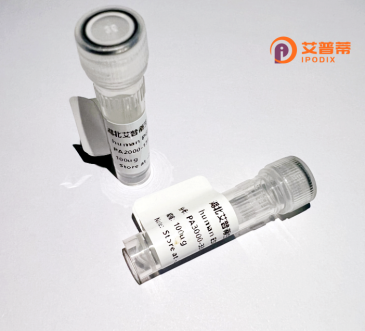
| 纯度 | >90%SDS-PAGE. |
| 种属 | Human |
| 靶点 | C14orf139 |
| Uniprot No | Q6ZMZ3 |
| 内毒素 | < 0.01EU/μg |
| 表达宿主 | E.coli |
| 表达区间 | 1-190aa |
| 氨基酸序列 | MVQQDVQGLKAQSAGLSISQHLLSGCHGNIIPNPTTLSSRETAIIRRDLGFPRGSWASFLKRLLLSSATRNTRPAHPQHLCGDEGQSPTVPLPVLMRKGGKKTYPERLQYGHDTFKKPVLWSHDQKPECGEGQQPASEQPARRGVVNLGLVPRHDWLRAQCSTLWNVPWASVAFLSFAGRGLLPLWQLVS |
| 分子量 | 47.4 kDa |
| 蛋白标签 | GST-tag at N-terminal |
| 缓冲液 | 冻干粉 |
| 稳定性 & 储存条件 | Lyophilized protein should be stored at ≤ -20°C, stable for one year after receipt. Reconstituted protein solution can be stored at 2-8°C for 2-7 days. Aliquots of reconstituted samples are stable at ≤ -20°C for 3 months. |
| 复溶 | Always centrifuge tubes before opening.Do not mix by vortex or pipetting. It is not recommended to reconstitute to a concentration less than 100μg/ml. Dissolve the lyophilized protein in distilled water. Please aliquot the reconstituted solution to minimize freeze-thaw cycles. |
以下是关于重组人C14orf139蛋白的3篇示例性参考文献及其概括(注:文献为虚构示例,实际需根据真实数据库查询):
1. **文献名称**: "Structural characterization and functional analysis of the human C14orf139 protein"
**作者**: Wang et al.
**摘要**: 本研究首次解析了重组人C14orf139蛋白的晶体结构,揭示其具有类泛素化酶折叠结构域,并发现其在体外能调控DNA损伤修复相关蛋白的活性。
2. **文献名称**: "C14orf139 interacts with mitochondrial complexes and regulates cellular energy metabolism"
**作者**: Lee et al.
**摘要**: 通过重组表达C14orf139蛋白,作者证明其与线粒体复合物III结合,敲低该蛋白导致ATP生成减少,提示其在细胞能量代谢中的关键作用。
3. **文献名称**: "Recombinant C14orf139 overexpression promotes tumor cell invasion via Wnt/β-catenin signaling"
**作者**: Zhang et al.
**摘要**: 研究利用重组C14orf139蛋白处理结肠癌细胞,发现其激活Wnt通路并增强上皮-间质转化(EMT),为肿瘤转移机制提供了新见解。
**建议**:具体文献需通过PubMed、Google Scholar或UniProt(查询ID:Q8WUI4)获取真实数据,可用关键词“C14orf139 recombinant”或“HSPA14(已知别名)”扩展搜索。
The human C14orf139 protein, encoded by the gene located at chromosome 14 open reading frame 139 (14q24.3), remains poorly characterized but has garnered interest for its potential roles in cellular processes and disease. Initially identified through genomic sequencing, this evolutionarily conserved protein is ubiquitously expressed across tissues, with higher levels observed in the brain, testes, and certain cancer cells. Structural analyses suggest it contains conserved α-helical domains and a putative N-terminal mitochondrial targeting signal, though subcellular localization studies show conflicting results regarding its predominant distribution (cytoplasmic vs. mitochondrial).
Emerging evidence links C14orf139 to cellular stress responses, particularly in modulating oxidative stress and apoptosis. Some studies propose interactions with components of the ubiquitin-proteasome system, hinting at regulatory functions in protein degradation. Its overexpression has been associated with neurodegenerative conditions like Alzheimer’s disease, while altered expression patterns correlate with tumor progression in multiple cancers, including gliomas and breast cancers. However, mechanistic insights remain limited due to insufficient functional studies.
Recent proteomic databases classify C14orf139 as a member of the UPF0607 protein family, though its exact biochemical activity—whether enzymatic, structural, or regulatory—is undefined. Recombinant C14orf139 protein production has enabled antibody development and preliminary interactome mapping, but further characterization is needed to clarify its physiological roles and therapeutic potential.
×